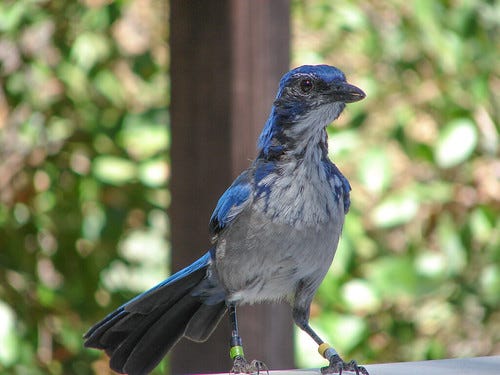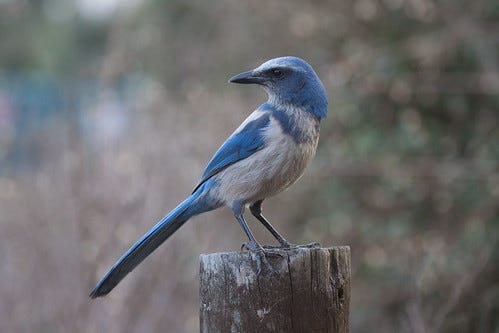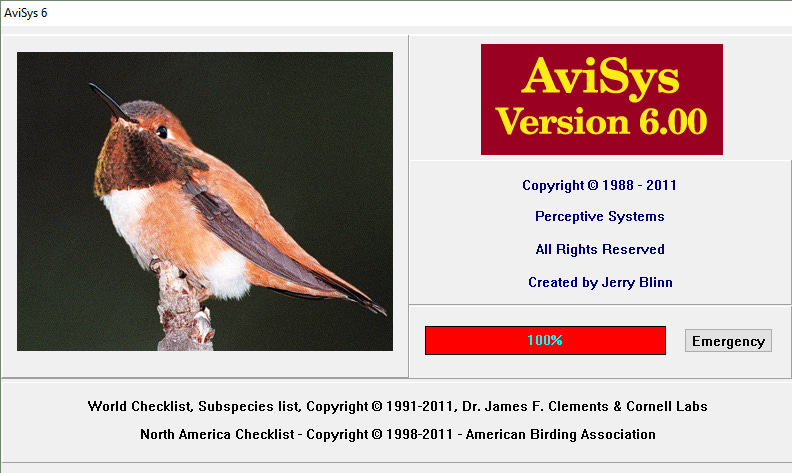The Value of eBird, Part 2
No one should go through life listlessly
(Listen to the radio version here.)
The day I identified my first chickadee with my new binoculars and field guide, I started my life list in a loose-leaf notebook. Whenever I identified a bird, I wrote down the species, date, place, weather conditions, and sometimes a few other details. My life list grew slowly—between March 2 and the end of May, I got it up to 40 species. At the time, that seemed like a lot!
In June I took a field ornithology class at the Kellogg Biological Station, and in three weeks more than doubled what I’d seen in three months, getting my life list to 90. For class, we had to keep two separate sets of notes: an overview of each field trip with a list of what we saw, and separate notes on each species, including accurate counts and behavior descriptions every time we saw it.
I stayed in pretty good habits through my second ornithology class the next spring. Again we had to turn in our field notebooks, including data about each outing along with detailed notes about each encounter with each species. After that, I got a little sloppier but kept up fairly well through 1979, when my life list was almost up to 400. At that point, my overviews of my outings and my species accounts stuffed four notebooks beyond capacity, making page turning difficult.
That’s when I switched to bound record books. I still recorded my life list in a separate notebook until 1989 when I was closing in on 500. It’s messy from crossing out lumped species, squeezing in new ones after splits, and keeping up with name changes.
In 1987, I bought a large, hardbound checklist for entering the birds I’d seen in each state and province in Canada and the continental US. Filling that in took a lot of time. It made a nice overview of more than a decade of birding, but being printed and bound, it had serious limitations due to newly lumped and split species. For example, it lists only a single scrub jay when there are now four separate species.

A lot of my birding friends simply mark each new species into their field guide, but that makes it hard to keep track of the order in which we saw them. I love remembering that #300 on my life list was White-tailed Kite, seen in Texas on December 29, 1978, and #400 was Franklin’s Gull, seen in Milwaukee on August 31, 1980. Russ sent me on one of Kim Eckert’s “Minnesota Birding Week” trips to Texas in 1991 to get my life list up to 500 before I turned 40. The milestone bird was a Seaside Sparrow on February 9, 1991. I’d read about the “600 Club” when I was starting out, and my #600 was an amazingly splendid bird, the Florida Scrub-Jay, which I saw on a family trip to Florida over spring break in 1999, my whole family along to share the joy.
Two years later, I took my first trips south of the border, to Costa Rica and Trinidad and Tobago. I saw 451 species in Costa Rica and 148 in Trinidad, over 400 of them lifers. My #1000 bird was the Bearded Bellbird.

By then I’d stopped using my paper notebooks for good. Fortunately, we had a home computer. In 1988, a birder named Jerry Blinn released AviSys, database software that allowed even the least computer-savvy among us to enter our data as long as we had a PC, not a Mac.
Jerry used checklist data produced by Shawneen Finnegan for Santa Barbara Software. I bought AviSys in time to enter my Costa Rica birds into it along with a quarter century of earlier birding data. AviSys was affordable and easy to use except every few years when the American Ornithologists’ Union released a new checklist with lumps, splits, and name changes. I’d have to upgrade the software and change some species entries myself, which sometimes took a whole weekend. When I switched to a Mac after I started working at the Cornell Lab of Ornithology in 2008, suddenly AviSys wasn’t so easy, and I needed special software for my Mac to run it.
AviSys worked wonderfully for PC users until Jerry got sick and stopped updating it. By the time of his death in 2015, Shawneen Finnegan was ready to let go of her responsibilities keeping her Santa Barbara Software world lists up to date. By then, though, many of us who’d been using AviSys had already started using eBird. Jerry worked with the eBird team to help people transfer their AviSys data to eBird, but I never figured out how thanks to my difficulties running Windows software on a Mac. I still have my AviSys data on floppy disks, but don’t know when or if I’ll ever be able to get all my historical data into eBird except by slowly entering my old lists from my field notebooks. Oh, well—it was fun while it lasted.
Projects of passion are seldom profitable—Jerry had a day job and didn’t worry about making money on AviSys, but when he couldn’t keep up with it anymore, no one took it over. Some birders may still use it, but as operating systems keep upgrading, eventually AviSys will work only on old PCs. Thanks to eBird, it had become redundant anyway.
Like AviSys, eBird was developed by passionate, knowledgeable individuals, but they work through the Cornell Lab of Ornithology, with all the long-term stability of a major, well-funded non-profit. eBird keeps up with taxonomy seamlessly, changing species names and lumped species automatically. And it usually enters splits automatically, too, when it can tell by location which newly recognized species a bird on our checklist belongs to.
The Lab puts a lot of resources into eBird not simply to make birders happy but to provide a massive body of data for their own and other scientific researchers. But making birders happy is the key to their success. In May, 2021, eBird was up to one billion bird observations from 77,466,000 birding checklists submitted by 684,300 eBirders from 202 countries.
There are lots of bird listing software products available—mostly commercial, some free. A few may allow easy exporting of data to eBird, but eBird is so easy to begin with and does so much more than any other bird-listing programs as far as sharing information from other birders that most serious birders now cut to the chase and don’t use anything else. Some state ornithological societies offer their own online reporting systems, but most birders want a single program that keeps track of all their birds. And each state’s reporting system must be kept up to date by a good programmer, work that can more easily be done by the eBird team than a volunteer, so most state ornithological societies now use eBird to gather data for seasonal reports, breeding bird atlases, and other projects.
So as far as birders keeping track of all our sightings, eBird is a game changer. And as much as I value it as a birder, I value it much, much more as a person who cares about birds for their own sakes. eBird’s value for research, education, and conservation cannot be overstated. But that’s a story for next time.







